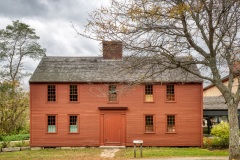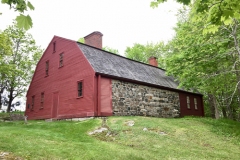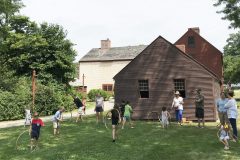The Old York Chapter NSDAR was organized January 9, 1914, with twelve charter members, including Mary Truesdell who was the founder and first regent. The chapter was so named for the historical setting of the town of York, which dates back to the sixteenth century. The town was settled about 1624 and originally was called Agamenticus. The city charter in 1641 called the town Gorgeana. This was the first chartered city in the English colony. In 1652 it was organized into a town named York from the English town. It was the second town in the state. The English changed the name of New Amsterdam to New York in 1664; therefore, York became known as Old York amongst sea captains to differentiate the two locations. It remained Old York until the late 19th and early 20th centuries. The Old York Chapter NSDAR was the 22nd chapter to organize in Maine on January 9, 1914. The object of the chapter was to review the history of York and mark historic sites in town including Patriot graves.
Eight historic buildings are open to the public. Costumed guides interpret the life and industry of the 18th and 19th century York at the following buildings: the Old Gaol (1719), the Emerson-Wilcox House (1742), Jefferds’ Tavern (c. 1750), the Old Schoolhouse (1870), the John Hancock Warehouse (c. 1750), the George Marshall Store (1870), the Elizabeth Perkins House (1732), and the Jonathan Sayward House (1719).
York is comprised of four areas: York Village at times referred to as “Olde York”, York Harbor, York Beach, and Cape Neddick. It is located approximately ten miles north of Portsmouth, New Hampshire, on Route 1/Route 1A.
The chapter marked several historic sites in York. Sewall’s Bridge over the York River was the first wooden pile drawbridge in North America with thirteen spans. The site of Gorgeana’s (Town of York) first chapel located on the site of the current St. George’s Episcopal Church in York Harbor was marked in 1932. The chapter also commemorated the organizing and departure of York’s Minutemen, the first Regiment in Maine to respond to the Lexington Concord Alarm in 1775, with a marker on the York Village Green. Numerous Revolutionary War Patriots’ graves have been marked throughout the State of Maine.

Learn more about our chapter events and Patriots. Was one of your relatives a member of our chapter? Meet our officers, and past chapter regents. You may find a family name! We would love to have you join our chapter, and help us prepare to celebrate the 250th Anniversary of America!




